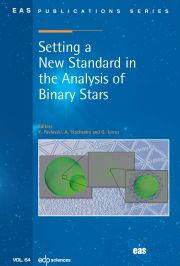Article contents
Global radiation-hydrodynamics simulations of red supergiantstars
Published online by Cambridge University Press: 23 May 2013
Abstract
The small-scale surface granulation on cool main-sequence stars and white dwarfsinfluences the overall appearance of these objects only weakly. And it is only indirectlyobservable by analyzing e.g. line-shapes or temporal fluctuations –except for the Sun. The large-scale and high-contrast convective surface cells andaccompanying sound waves on supergiants and low-gravity AGB stars on the other hand have astrong impact on the outer atmospheric layers and are directly detectable byinterferometric observations.
Necessary to interpret modern observations with their high resolution in frequency, time,and/or space are detailed numerical multi-dimensional time-dependentradiation-hydrodynamical simulations. Local simulations of small patches of convectivesurface layers and the atmosphere of main-sequence stars have matured over three decadesand have reached an impressive level of agreement with observations and also betweendifferent computational codes. However, global simulations of the entire convectivesurface and atmosphere of a red supergiants are considerably more demanding – and limited– and have become available only for about one decade.
Still, they show how the surface is shaped by the interaction of small surface granules,that sit on top of large envelope convection cells, and waves, that can travel as shocksinto the outer atmosphere. The route to more complete future models will be discussed,that comprise the outer atmosphere of the stars and that could explain some of thelittle-understood phenomena like chromosphere, molsphere, or wind-formation.
Information
- Type
- Research Article
- Information
- Copyright
- © EAS, EDP Sciences 2013
References
- 6
- Cited by

